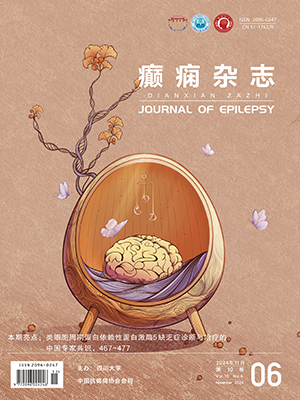| 1. |
Eilbert W, Chan C. Febrile seizures: A review. Journal of the American College of Emergency Physicians Open, 2022, 3(4): e12769.
|
| 2. |
Kwon A, Kwak BO, Kim K, et al. Cytokine levels in febrile seizure patients: A systematic review and meta-analysis. Seizure, 2018, 59: 5-10.
|
| 3. |
Ha J, Choi J, Kwon A, et al. Interleukin-4 and tumor necrosis factor-alpha levels in children with febrile seizures. Seizure, 2018, 58: 156-162.
|
| 4. |
Tang H, Wang X. PD-1 is an immune-inflammatory potential biomarker in cerebrospinal fluid and serum of intractable epilepsy. BioMed Research International, 2021, 2021: 1-10.
|
| 5. |
Naimo GD, Guarnaccia M, Sprovieri T, et al. A systems biology approach for personalized medicine in refractory epilepsy. International Journal of Molecular Sciences, 2019, 20(15): 3717.
|
| 6. |
Kumar P, Shih DCW, Lim A, et al. Proinflammatory IL-17 pathways dominate the architecture of the immunome in pediatric refractory epilepsy. JCI Insight, 2019, 4(8): e126337.
|
| 7. |
Symonds JD, Zuberi SM, Stewart K, et al. Incidence and phenotypes of childhood-onset genetic epilepsies: a prospective population-based national cohort. Brain, 2019, 142(8): 2303-2318.
|
| 8. |
Chen KD, Hall AM, Garcia‐Curran MM, et al. Augmented seizure susceptibility and hippocampal epileptogenesis in a translational mouse model of febrile status epilepticus. Epilepsia, 2021, 62(3): 647-658.
|
| 9. |
Garcia-Curran MM, Hall AM, Patterson KP, et al. Dexamethasone attenuates hyperexcitability provoked by experimental febrile status epilepticus. eneuro, 2019, 6(6): 430.
|
| 10. |
Wang L, Song L, Chen X, et al. microRNA‐139‐5p confers sensitivity to antiepileptic drugs in refractory epilepsy by inhibition of MRP1. CNS Neuroscience & Therapeutics, 2020, 26(4): 465-474.
|
| 11. |
Tang F, Hartz AMS, Bauer B. Drug-resistant epilepsy: multiple hypotheses, few answers. Frontiers in Neurology, 2017, 8: 301.
|
| 12. |
Lim A, Thomas RH. The mitochondrial epilepsies. European Journal of Paediatric Neurology, 2020, 24: 47-52.
|
| 13. |
Dombroski TCD, Peixoto‐Santos JE, Maciel K, et al. Drebrin expression patterns in patients with refractory temporal lobe epilepsy and hippocampal sclerosis. Epilepsia, 2020, 61(8): 1581-1594.
|
| 14. |
Fu M, Tao J, Wang D, et al. Downregulation of MicroRNA-34c-5p facilitated neuroinflammation in drug-resistant epilepsy. Brain Research, 2020, 1749: 147130.
|
| 15. |
Froklage FE, Postnov A, Yaqub MM, et al. Altered GABA A receptor density and unaltered blood–brain barrier [ 11 C]flumazenil transport in drug-resistant epilepsy patients with mesial temporal sclerosis. Journal of Cerebral Blood Flow & Metabolism, 2017, 37(1): 97-105.
|
| 16. |
Ethemoglu O, Calık M, Koyuncu I, et al. Interleukin-33 and oxidative stress in epilepsy patients. Epilepsy Research, 2021, 176: 106738.
|
| 17. |
Mosili P, Maikoo S, Mabandla M Vuyisile, et al. The pathogenesis of fever-induced febrile seizures and its current state. Neuroscience Insights, 2020, 15: 263310552095697.
|
| 18. |
El-Masry HMA, Sadek AA, Hassan MH, et al. Metabolic profile of oxidative stress and trace elements in febrile seizures among children. Metabolic Brain Disease, 2018, 33(5): 1509-1515.
|
| 19. |
Klement W, Blaquiere M, Zub E, et al. A pericyte‐glia scarring develops at the leaky capillaries in the hippocampus during seizure activity. Epilepsia, 2019, 60(7): 1399-1411.
|
| 20. |
Liu Z, Xian H, Ye X, et al. Increased levels of NLRP3 in children with febrile seizures. Brain and Development, 2020, 42(4): 336-341.
|
| 21. |
Kim K, Kwak BO, Kwon A, et al. Analysis of plasma multiplex cytokines and increased level of IL-10 and IL-1Ra cytokines in febrile seizures. Journal of Neuroinflammation, 2017, 14(1): 200.
|
| 22. |
Şahin S, Uysal S, Yentür SP, et al. Reduced cerebrospinal fluid levels of interleukin-10 in children with febrile seizures. Seizure, 2019, 65: 94-97.
|
| 23. |
Zhu H, Wang G, Bai Y, et al. Natural bear bile powder suppresses neuroinflammation in lipopolysaccharide-treated mice via regulating TGR5/AKT/NF-κB signaling pathway. Journal of Ethnopharmacology, 2022, 289: 115063.
|
| 24. |
van Scheppingen J, Mills JD, Zimmer TS, et al. miR147b: A novel key regulator of interleukin 1 beta-mediated inflammation in human astrocytes. Glia, 2018, 66(5): 1082-1097.
|
| 25. |
Alvim MKM, Morita‐Sherman ME, Yasuda CL, et al. Inflammatory and neurotrophic factor plasma levels are related to epilepsy independently of etiology. Epilepsia, 2021, 62(10): 2385-2394.
|
| 26. |
Yu X, Zhang N, Liu S, et al. Polymorphisms in the interleukin-1β (IL-1B) and interleukin-1α (IL-1A) genes on risk of febrile seizures: a meta-analysis. Neurological Sciences, 2018, 39(9): 1529-1536.
|
| 27. |
Westbrook C, Subramaniam T, Seagren RM, et al. Febrile infection-related epilepsy syndrome (fires) treated successfully with anakinra in a 21-year-old woman. Brain & Dev, 2020, 10: 216-223.
|
| 28. |
Parsons ALM, Bucknor EMV, Castroflorio E, et al. The interconnected mechanisms of oxidative stress and neuroinflammation in epilepsy. Antioxidants, 2022, 11(1): 157.
|
| 29. |
Fabisiak T, Patel M. Crosstalk between neuroinflammation and oxidative stress in epilepsy. Frontiers in Cell and Developmental Biology, 2022, 10: 976953.
|
| 30. |
Zilberter Y, Popova I, Zilberter M. Unifying mechanism behind the onset of acquired epilepsy. Trends in Pharmacological Sciences, 2022, 43(2): 87-96.
|
| 31. |
Kösem A, Yücel Ç, Titiz AP, et al. Evaluation of serum thiol-disulphide homeostasis parameters as oxidative stress markers in epilepsy patients. Acta Neurologica Belgica, 2021, 121(6): 1555-1559.
|
| 32. |
Yang N, Guan QW, Chen FH, et al. Antioxidants targeting mitochondrial oxidative stress: promising neuroprotectants for epilepsy. Oxidative Medicine and Cellular Longevity, 2020, 2020: 1-14.
|
| 33. |
Süße M, Gag K, Hamann L, et al. Time dependency of CSF cell count, lactate and blood-CSF barrier dysfunction after epileptic seizures and status epilepticus. Seizure, 2022, 95: 11-16.
|
| 34. |
Gao C, Yu Y, Wen C, et al. Nonstructural protein nss activates inflammasome and pyroptosis through interaction with NLRP3 in human microglial cells infected with severe fever with thrombocytopenia syndrome bandavirus. Journal of Virology, 2022, 96(13): e00167-22.
|
| 35. |
Hu A, Yuan H, Qin Y, et al. Lipopolysaccharide (LPS) increases susceptibility to epilepsy via interleukin-1 type 1 receptor signaling. Brain Research, 2022, 1793: 148052.
|
| 36. |
Kodali MC, Chen H, Liao FF. Temporal unsnarling of brain’s acute neuroinflammatory transcriptional profiles reveals panendothelitis as the earliest event preceding microgliosis. Molecular Psychiatry, 2021, 26(8): 3905-3919.
|
| 37. |
Cousins O, Hodges A, Schubert J, et al. The blood–CSF–brain route of neurological disease: The indirect pathway into the brain. Neuropathology and Applied Neurobiology, 2022, 48(4): e12789.
|
| 38. |
Pellegrini L, Albecka A, Mallery DL, et al. SARS-CoV-2 infects the brain choroid plexus and disrupts the blood-CSF barrier in human brain organoids. Cell Stem Cell, 2020, 27(6): 951-961.
|
| 39. |
Dürr M, Nissen G, Sühs KW, et al. CSF findings in acute nmdar and lgi1 antibody-associated autoimmune encephalitis. neurology-neuroimmunology. Neuroinflammation, 2021, 8(6): e1086.
|
| 40. |
Vezzani A, Balosso S, Ravizza T. Neuroinflammatory pathways as treatment targets and biomarkers in epilepsy. Nature Reviews Neurology, 2019, 15(8): 459-472.
|
| 41. |
van Lanen RH, Melchers S, Hoogland G, et al. Microvascular changes associated with epilepsy: A narrative review. Journal of Cerebral Blood Flow & Metabolism, 2021, 41(10): 2492-2509.
|
| 42. |
Feng L, Shu Y, Wu Q, et al. EphA4 may contribute to microvessel remodeling in the hippocampal CA1 and CA3 areas in a mouse model of temporal lobe epilepsy. Molecular Medicine Reports, 2017, 15(1): 37-46.
|
| 43. |
Castañeda-Cabral JL, Colunga-Durán A, Ureña-Guerrero ME, et al. Expression of VEGF- and tight junction-related proteins in the neocortical microvasculature of patients with drug-resistant temporal lobe epilepsy. Microvascular Research, 2020, 132: 104059.
|
| 44. |
Prager O, Kamintsky L, Hasam‐Henderson LA, et al. Seizure‐induced microvascular injury is associated with impaired neurovascular coupling and blood–brain barrier dysfunction. Epilepsia, 2019, 60(2): 322-336.
|
| 45. |
Nuñez-Lumbreras M de los Á, Castañeda-Cabral JL, Valle-Dorado MG, et al. Drug-resistant temporal lobe epilepsy alters the expression and functional coupling to Gαi/o proteins of CB1 and CB2 receptors in the microvasculature of the human brain. Frontiers in Behavioral Neuroscience, 2021, 14: 611780.
|
| 46. |
Ureña-Guerrero ME, Castañeda-Cabral JL, Rivera-Cervantes MC, et al. Neuroprotective and neurorestorative effects of Epo and VEGF: perspectives for new therapeutic approaches to neurological diseases. Current Pharmaceutical Design, 2020, 26(12): 1263-1276.
|
| 47. |
Baruah J, Vasudevan A, Köhling R. Vascular integrity and signaling determining brain development, network excitability, and epileptogenesis. Frontiers in Physiology, 2020, 10: 1583.
|
| 48. |
Whitebirch AC, LaFrancois JJ, Jain S, et al. Enhanced excitability of the hippocampal CA2 region and its contribution to seizure activity in a mouse model of temporal lobe epilepsy. Neuron, 2022, 110(19): 3121-3138.e8.
|
| 49. |
Yu YH, Lee K, Sin DS, et al. Altered functional efficacy of hippocampal interneuron during epileptogenesis following febrile seizures. Brain Research Bulletin, 2017, 131: 25-38.
|
| 50. |
Freiman TM, Häussler U, Zentner J, et al. Mossy fiber sprouting into the hippocampal region CA2 in patients with temporal lobe epilepsy. Hippocampus, 2021, 31(6): 580-592.
|




